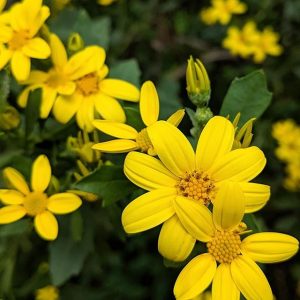Boneseed (Chrysanthemoides monilifera ssp. monilifera), a South African coastal shrub aster now more widespread in Australia and New Zealand than in its native range.
Boneseed was imported to Australia by the 1850s, when it was grown at Elizabeth Bay NSW and at the Melbourne Botanic Gardens. Despite numerous botanical records of the plants naturalising in coastal NSW and South Australia from the 1880s, and coastal Victoria in the 1910s and 1920s, the species was adopted by mid-century land managers as an erosion control planting.
As one 1960s account dryly noted, Boneseed ‘is often grown in gardens, but it attains its best development in places where it is not wanted.’ The species thrives on dry, infertile exposures and establishes a persistent seed bank from which it quickly dominates landscapes after fire or other disturbance. A large bush may produce 50,000 seeds in one season.
The consequences of its intentional use by land managers were devastating for a number of key natural areas. At the You Yangs peaks, 1600 ha of granitic woodlands were converted over several decades to Boneseed-dominated mono-thicket. Sand and gravel quarries at the You Yangs also continue to be a source for new introductions of the species throughout Victoria.
Amidst growing realisation of the Boneseed disaster at the You Yangs and other sites (the Mornington coast, the Lower Glenelg), the species was declared noxious in Victoria in 1969. Despite this, as shockingly late as 1980 the NSW Department of Agriculture was not only still using Boneseed as an erosion control planting, but arguing that it was too valuable to prohibit. In 2000, the species was determined to be a weed of national significance.
The photographed plants were found in the central valley of the Maribyrnong River and on the adjacent Solomon Heights, a notable but highly damaged escarpment scrub-grassland landscape that has been held in development limbo since the 1920s.
View Original Post on Instagram
Search for information about Chrysanthemoides monilifera ssp. monilifera in the Flora of Victoria
View information and occurrences of Chrysanthemoides monilifera ssp. monilifera on the Atlas of Living Australia










